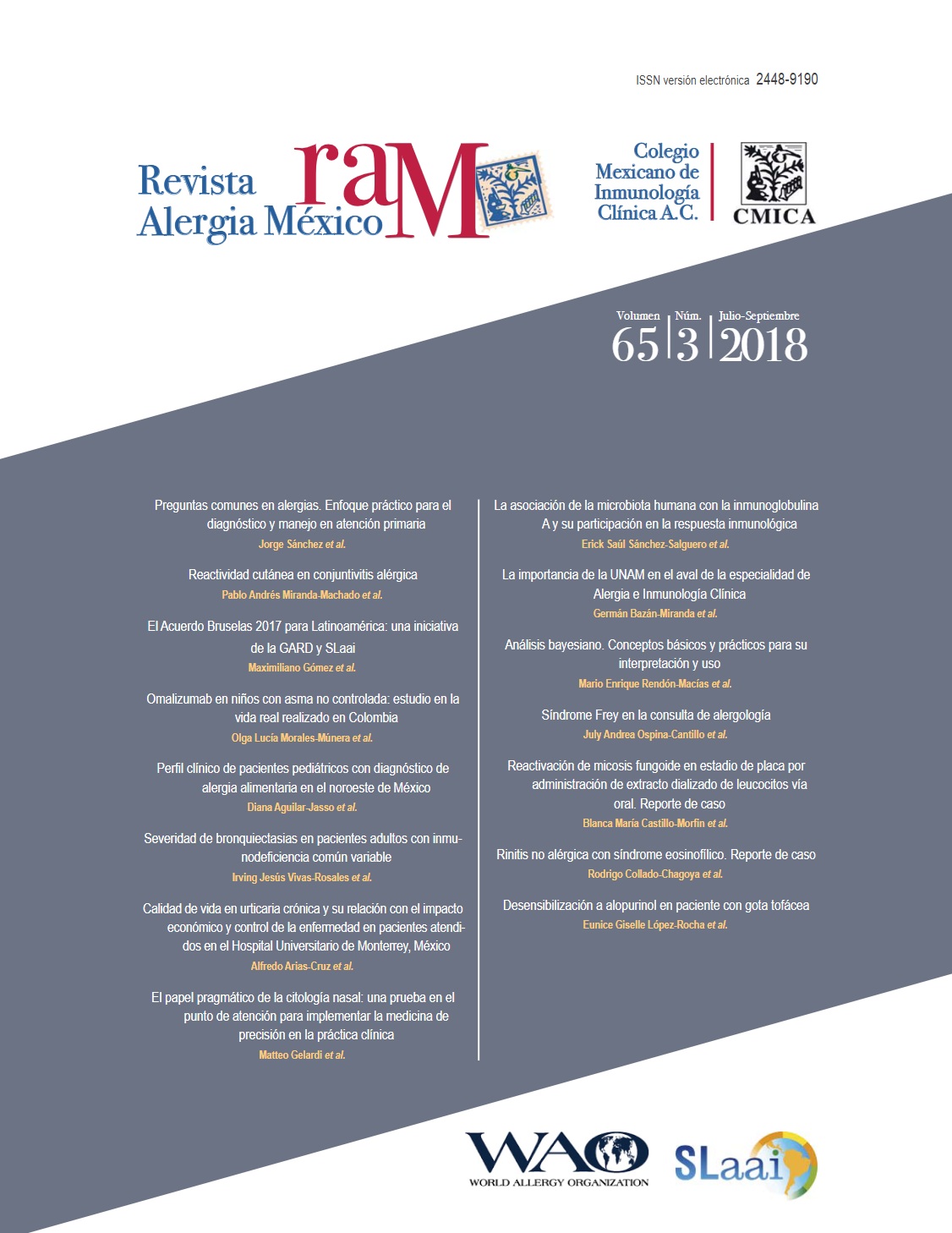Abstract
Bayesian statistics is based on subjective probability. It works with evidence updating considering the knowledge acquired prior to an investigation, plus the evidence obtained thereof. Results’ interpretation requires for the hypotheses to be tested to be specified and their a priori probability to be estimated before the study. Study evidence is measured with the Bayes factor (compatibility ratio of the data under the proposed hypotheses). The conjunction of hypotheses a priori probabilities with the Bayes factor allows calculating the a posteriori probability of each one of them. The hypothesis with the highest degree of certainty at its update is the one that is accepted for decision making. In this review, three examples of hypothesis to be tested are shown: difference of means, correlation and association.
References
Kruschke JK. Introduction. En: Doing Bayesian data analysis. A tutorial with R, JAGS, and Stan. EE. UU.: Elsevier; 2015. DOI: 10.1016/C2012-0-00477-2
Goodman SN. Introduction to Bayesian methods I: measuring the strength of evidence. Clin Trials. 2005;2(4):282-290. DOI: 10.1191/1740774505cn098oa
Peter M Lee. Bayesian statistic: an introduction. EE. UU.: John Wiley & Sons, Ltd; 2000.
Indrayan A, Kumar-Malhotra R. Medical biostatistics. EE. UU.: Chapman & Hall/Chemical Rubber Company Press; 2008.
Krzywinski M, Altman N. Significance, P values and t-tests. Nat Methods. 2013;10(11):1041-1042.
Buchinsky FJ, Chadha NK. To P or not to P: backing Bayesian statistics. Otolaryngol Head Neck Surg. 2017;157(6):915-918. DOI: 10.1177/0194599817739260
Dienes Z, Mclatchie N. Four reasons to prefer Bayesian analyses over significance testing. Psychon Bull Rev. 2018;25(1):207-218. DOI: 10.3758/s13423-017-1266-z
Austin PC, Brunner LJ, Hux JE. Bayeswatch: an overview of Bayesian statistics. J Eval Clin Pract. 2002;8(2):277-286. DOI: 10.1046/j.1365-2753.2002.00338.x
Greenland S, Senn SJ, Rothman KJ, Carlin JB, Poole C, Goodman SN, et al. Statistical tests, P values, confidence intervals, and power: a guide to misinterpretations. Eur J Epidemiol. 2016;31(4):337-350. DOI: 10.1007/s10654-016-0149-3
Gelman A, Shalizi CR. Philosophy and the practice of Bayesian statistics. Br J Math Stat Psychol. 2013;66(1):8-38. DOI: 10.1111/j.2044-8317.2011.02037.x
Wagenmakers EJ, Marsman M, Jamil T, Ly A, Verhagen J, Love J, et al. Bayesian inference for psychology. Part I: theoretical advantages and practical ramifications. Psychon Bull Rev. 2018;25(1):35-57. DOI: 10.3758/s13423-017-1343-3
Etz A, Gronau QF, Dablander F, Edelsbrunner PA, Baribault B. How to become a Bayesian in eight easy steps: an annotated reading list. Psychon Bull Rev. 2018;25(1):219-234. DOI: 10.3758/s13423-017-1317-5
Statistical Methods for Research Workers. Reino Unido: Olivier & Boyd; 1932.
Neyman J, Pearson ES. On the problem of the most efficient tests of statistical hypotheses. Philos Trans R Soc Math Phys Eng Sci. 1933;231(694-706):289–337.
Nurminen M. Statistical significance-a misconstrued notion in medical research. Scand J Work Environ Health. 1997;23(3):232-235.
Masson ME. A tutorial on a practical Bayesian alternative to null-hypothesis significance testing. Behav Res Methods. 2011;43(3):679-690. DOI: 10.3758/s13428-010-0049-5
Cohen AL, Sidlowski S, Staub A. Beliefs and Bayesian reasoning. Psychon Bull Rev. 2017;24(3):972-978. Disponible en: https://link.springer.com/article/10.3758/s13423-016-1161-z
Goodman SN. Toward evidence-based medical statistics. 2: the Bayes factor. Ann Intern Med. 1999;130(12):1005-1013.
Stern HS. A test by any other name: P Values, Bayes factors, and statistical inference. Multivariate Behav Res. 2016;51(1):23-29. DOI: 10.1080/00273171.2015.1099032
Miller G, Martz H, Little T, Bertelli L. Bayesian hypothesis testing-use in interpretation of measurements. Health Phys. 2008;94(3):248-254. DOI: 10.1097/01.HP.0000290624.35701.00
Bittl JA, He Y. Bayesian analysis: a practical approach to interpret clinical trials and create clinical practice guidelines. Circ Cardiovasc Qual Outcomes. 2017;10(8):e003563. DOI: 10.1161/CIRCOUTCOMES.117.003563
Morey RD, Hoekstra R, Rouder JN, Lee MD, Wagenmakers EJ. The fallacy of placing confidence in confidence intervals. Psychon Bull Rev. 2016;23(1):103-123. DOI: 10.3758/s13423-015-0947-8
Van-Rijn MHC, Bech A, Bouyer J, Van-Den-Brand JAJG. Statistical significance versus clinical relevance. Nephrol Dial Transplant. 2017;32(Suppl 2):ii6–ii12. DOI: 10.1093/ndt/gfw385
Matthews RAJ. Beyond “significance”: principles and practice of the analysis of credibility. R Soc Open Sci. 2018;5(1):171047. DOI: 10.1098/rsos.171047
Rouder JN, Speckman PL, Sun D, Morey RD, Iverson G. Bayesian t tests for accepting and rejecting the null hypothesis. Psychon Bull Rev. 2009;16(2):225-237. DOI: 10.3758/PBR.16.2.225
Lecoutre B, Derzko G, Grouin JM. Bayesian predictive approach for inference about proportions. Stat Med. 1995;14(9-10):1057-1063.
Zaslavsky BG. Bayesian versus frequentist hypotheses testing in clinical trials with dichotomous and countable outcomes. J Biopharm Stat. 2010;20(5):985-997. DOI: 10.1080/10543401003619023
Martínez-Ezquerro JD, Riojas-Garza A, Rendón-Macías ME. Clinical significance vs statistical significance. How to interpret the confidence interval at 95. Rev Alerg Mex. 2017;64(4):477-486. DOI: 10.29262/ram.v64i4.334
Rottman BM. Physician Bayesian updating from personal beliefs about the base rate and likelihood ratio. Mem Cognit. 2017;45(2):270-280. DOI: 10.3758/s13421-016-0658-z
López-Puga J, Krzywinski M, Altman N. Points of significance: Bayesian statistics. Nat Methods. 2015;12(5):377-378.
Gurrin LC, Kurinczuk JJ, Burton PR. Bayesian statistics in medical research: an intuitive alternative to conventional data analysis. J Eval Clin Pract. 2000;6(2):193-204. DOI: 10.1046/j.1365-2753.2000.00216.x
Wagenmakers EJ, Beek TF, Rotteveel M, Gierholz A, Matzke D, Steingroever H, et al. Turning the hands of time again: a purely confirmatory replication study and a Bayesian analysis. Front Psychol. 2015;6:494. DOI: 10.3389/fpsyg.2015.00494
Greenland S, Poole C. Living with p values: resurrecting a Bayesian perspective on frequentist statistics. Epidemiology. 2013;24(1):62-68. DOI: 10.1097/EDE.0b013e3182785741
Bertram T. Significance testing —are we ready yet to abandon its use? Curr Med Res Opin. 2011;27(11):2087-2089.

This work is licensed under a Creative Commons Attribution-NonCommercial 4.0 International License.
Copyright (c) 2018 Revista Alergia México





